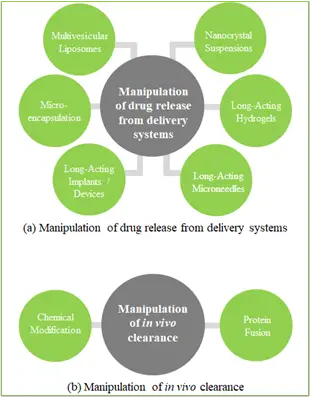
Over the last two decades, the pharmaceutical industry has observed a paradigm shift from conventional drug delivery strategies to the long-acting drug delivery (LADD) of products to treat several disease indications, such as ophthalmic disorders, oncological disorders, neurological disorders and infectious diseases. LADD has emerged as the novel and advanced drug delivery system which manipulate the dosing regimen of the drug in the body in order to sustain its therapeutic level. These novel systems circumvent the limitations of conventional drug delivery system, such as multiple dosing frequency, fluctuating plasma levels, high toxicity levels and poor patient compliance.
Principles and Strategies associated with Long-Acting Drug Delivery
Lately, many technologies are being explored to develop long-acting drugs in various dosage formats, such as long-acting injectables, depot injections, implantable devices and combination products. The LADD technologies have come a long way with the inclusion of liposomes, microspheres and polymers for the fabrication of biodegradable and biocompatible delivery system. Apart from this, the interdependency of drug, excipient and release environment plays a crucial role to decide the release kinetics of the drug.
The below figure highlights the underlying principles and various strategies associated with long-acting drug delivery.

What are the Benefits of Outsourcing to Contract Service Providers (CDMOs / CDOs / CMOs)?
One of the critical factors associated with the development of long-acting drugs is the selection of drug therapeutic window and its absorption characteristics. It also encompasses the quantitative determination of drug metabolism and pharmacokinetic (DMPK) properties. In addition, the formulation of these drugs is a complex process, especially if there is inclusion of highly potent molecules. Some of the other challenges include aseptic manufacturing, terminal sterilization, suitable characterization methods, lack of GMP-certified facilities and specialized equipment.

Owing to the advanced LADD technologies, formulation and developmental challenges associated with these complex dosage forms, the reliability on stakeholders having the expertise in this domain has upsurged. This will eventually aid the drug developers to address the bottlenecks stemming from conventional treatment options and improve the clinical outcome.
Bottom Line
Keeping every trend in mind, Roots Analysis has provided complete information on market trends in long-acting drug delivery domain, which has some of the very recent and precise activities listed for the clients to help them make better decisions in its report titled, Long-Acting Drug Delivery Technologies and Services Market, 2023-2035. To find answers to key decision-making question and to know further about the market forecast analysis, highlighting the likely growth of the long-acting drug delivery technologies and services market, for the time period 2023-2035.
The post <strong>Long-Acting Drug Delivery: A Novel Pharmacological Strategy to Deliver Therapeutic Modalities</strong> appeared first on Blog.
